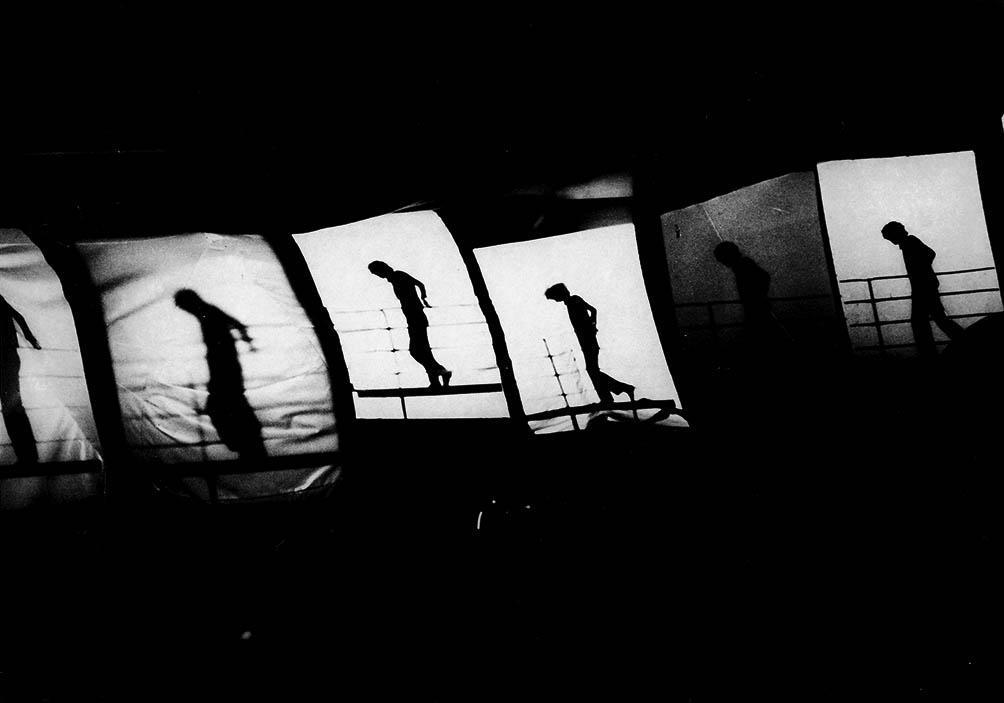
© Shuzo Azuchi Gulliver and SAGYO, Tokyo
Around the time Satō Jūshin became editor-in-chief in 1966, the film criticism journal Eiga Hyōron [Cinema criticism] began actively focusing on marginal works and artists, including documentaries, self-made films, and “pink” films (which have erotic content but are not out-and-out pornography). Filmmaker Iimura Takahiko, film critic Kanesaka Kenji, art critic Ishizaki Kōichirō, musician Tone Yasunao, and others wrote extensively on underground cinema, expanded cinema, and intermedia in this journal’s pages, familiarizing Japanese readers with these movements and terminologies. On the heels of the Sōgetsu Art Center, which had single-handedly led efforts to bring exposure to these movements, artists, and works, came a series of new screening venues: “Lunami Film Gallery” at Lunami Gallery in January 1967; the underground theater Jiyū Gekijō (Free Theater), where Satō himself organized regular screenings, in June; and Underground Sasoriza, launched by Art Theatre Shinjuku Bunka director Kuzui Kinshirō in August. With the student protest movement approaching its peak in 1968–69 and the hippie and psychedelic movements advancing as well, spaces not usually dedicated to film, such as universities, vocational schools, live music clubs, discotheques, nightclubs, and bars joined the above venues in organizing independent film screenings.
Kanesaka, who lived in the United States for an extended period in the mid-1960s, actively introduced American underground cinema and its theories, and as a filmmaker, produced Super Up (1966). In January 1967, a public happening was held to record sound for Hopscotch, a film shot and edited in the US and Japan. Given that the film was shot as a happening, musician Tone Yasunao suggested the film score recording also take the form of a happening, and he held a central role in the sound recording event with free jazz musicians Yamashita Yōsuke and Yoshizawa Motoharu, filmmaker Miyai Rikurō, photographer Morita Ichirō, as well as Satō and others participating. Conducted at the Sōgetsu Art Center, where the center of gravity shifted from music to film in the late 1960s, this was a seminal experiment that combined the two. “Hopscotch: A Found Sound Happening” (‘Ishikeri’ no otoire hapuninngu) is a valuable report on the event, written by Tone and published in Eiga Hyōron [Cinema criticism].
Jōnouchi Motoharu, who had produced Document 6.15 (Dokyumento 6.15, 1961), which covered the 1960 struggle over the US-Japan Security Treaty, documented Shelter Plan (Sheltā puran, 1964), a happening staged by the artists Akasegawa Genpei, Nakanishi Natsuyuki, and Takamatsu Jirō (of the group Hi Red Center) and their associates at the Imperial Hotel. After this, Jōnouchi turned his camera back to the protest movement as a new student leftism emerged in the late 1960s. He produced a series that began with Nihon University Hakusan Street (Nichidai Hakusan- dōri, 1968), which documented unrest at Nihon University, and continued with Nihon University Public Collective Bargaining (Nichidai taishū danko, 1968), Gewaltopia Trailer (Gebarutopia yokokuhen, 1969), and Shinjuku Station (Shinjuku sutēshon, 1968- 74), which portrays an uprising in Shinjuku on International Anti-War Day on October 21, 1968. “Gewaltopia” was a concept of Jōnouchi’s, combining Gewalt (German for “force” or “violence,” but usually used in Japan in reference to violent left-wing student protest and clashes with authorities), and utopia. The related production was originally conceived not as a single work but as an unbroken, potentially endless series of film footage. “Silver Screen, Die! — Preface to an Essay on a Lemniscate” (Ginmakuyo shine! —Yokohachimojiron joron) was a poetic manifesto that appeared in 1968 in the industry journal Kaku, published by commercial filmmakers and associates including Jōnouchi. Yokohachimoji literally means “sideways figure eight” and is a Japanese rendering of the infinity symbol. The text introducing this new theory thoroughly rejected conventional filmmaking and advocated a fusion of new cinematic experimentation and daily life.
Shūzō Azuchi Gulliver, active as a visual artist and performer since the mid-1960s, produced film works such as SWITCH, WATCH, FILM, SCREEN and BOX in 1966 and 1967. Utilizing the characteristics of cinema — twenty-four still images per second printed on rolls of film, run through a projector to become light and shadow, which is cast on a rectangular white screen, in a dark theater, and viewed by an audience — he produced a body of work, not so much films or video art pieces as philosophical experiments with the cinematic, using a variety of approaches to deliberately dissect the medium. Tone wrote a treatise on him, “On Gulliver” (Garibā no koto) published as a flyer distributed at Two Men Shy in the Face of Andy Warhol / Underground Cinema Shinjuku a Go! Go! Go! (Andī wōhōru ni hajirau futari no otoko andā guraundo shinema shinjuku a gō gō gō, 1968), a two-person event series with Miyai Rikurō.
Artist Ōe Masanori, who moved to New York’s East Village in 1965, began making films at the height of the psychedelic movement, producing Loop Siki (1966), Head Game (1967), which documents a “be-in” in Central Park, and No Game (1967), which chronicles a demonstration at the Pentagon on International Anti- War Day, while participating in the Newsreel collective along with Jonas Mekas and others. Great Society (1967) collaged newsreel footage of the massive political, social, and cultural upheavals of 1960s America with footage he had shot himself, and was projected simultaneously on six screens. After returning to Japan in 1969, he worked to bring a psychedelic revolution to the country in both theory and practice, and established Newsreel Japan with Kanesaka and the photographer Nakahira Takuma. In 1970 he participated in activities of Banpaku Hakai Kyōtō-ha [Expo ’70 Destruction Joint- Struggle Group] opposing Expo ’70 Osaka, and was cameraman for the film White Hare of Inaba (Inaba no shiro usagi, 1970) by artist and leader of Zero Jigen [Zero Dimension] group, Katō Yoshihiro. Ōe called for a new spiritual revolution in “The Aesthetics of Ecstasy and the Yippie Revolution” (Kōkotsu no bigaku to ippī reborūshon) published in Eiga Hyōron [Cinema criticism].
Go Hirasawa